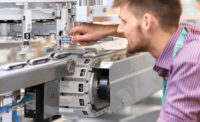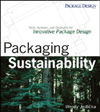Sustainability has become the mantra of the packaging world. No matter which way you look, companies are developing new products and processes that will reduce packaging’s impact on the environment.
Nowhere is this movement more critical than in the flexible packaging space. Currently, flexible packaging is the fast-growing segment of the industry. The main factor limiting its growth is recyclability, since many pouches and bags use laminated structures of different materials that are difficult to recycle. And plastics, the primary material, can take centuries to break down in the environment.
If anyone has an awareness of how the industry is progressing, that person would be Nina Goodrich, director of the Sustainable Packaging Coalition. Flexible Packaging recently met with her to discuss advances in packaging sustainability. Goodrich has held leadership positions in sustainability and R&D with Alcan Packaging, Amcor, Guelph Food Technology Center and Magic Pantry Foods. She also has done graduate work in technology management and holds a BA in molecular biology from Wellesley College.
Benefits of Flexible Packaging
Goodrich says flexible packaging is a very valuable form of packaging because it has a low carbon footprint and it offers a high level of product protection. Many people lose sight of the fact that if a product spoils or gets damaged, that is not very sustainable because the footprint of the product is often greater than that of the package. Where flexible packaging often falls down is on recyclability.
“The focus has been on plastics in the last year, but I think the focus needs to be on all materials,” Goodrich says. “We need to create an infrastructure that allows all materials to be collected, sorted and reprocessed to become feedstock for other processes.” She adds that that a circular economy is absolutely critical, and it is bigger and more important than just recycling.” We can’t have status quo answers to these big problems.”
Many companies are making tradeoffs with unintended consequences. “All materials have tradeoffs. It depends on what you think is more important. If you think climate change is important, it doesn’t make sense to move to materials with a higher carbon footprint and less performance capability,” Goodrich says. “Everybody making these decisions really needs to think about it. I think the answer is infrastructure for all materials, and we haven’t really been good for any of them.”
Many brand owners and consumers think that recycling is the best way to make packaging more sustainable. Today, mechanical recycling is the main method used to recover and reuse materials used in packaging.
Mechanical recycling refers to operations that aim to recover plastics waste via mechanical processes, such as grinding, washing, separating, drying, re-granulating and compounding. Mechanical recycling can only be done a few times before the polymers break down and the quality of the plastic degrades.
However, this is not easily accomplished with flexible packaging because it often combines multiple materials that cannot be separated and which may contaminate the recycling process. Consequently, many recycling facilities will not accept flexible packaging. This reduces its value in the recycling marketplace.
Goodrich says the industry really needs a way to collect film that is not dependent on being sorted in material recycling facilities (MRF). Today, it costs $80 a ton to sort the current mix of materials in an MRF, while the combined sale value is somewhere between $30 and $40 — and that’s for rigid materials and paper, not flexibles.
Recycling Flexibles Is Expensive
“The last thing we want to do is send flexibles through that system to incur the burden of that cost,” she says. “We need a new way of collecting recyclables. My belief is that some version of the current Energy Bag solution where films and hard-to-recycle materials could be placed in a bag and then picked up in curbside collections. It would then go in a different direction.”
She also points out that the market is seeing a surge of companies wanting to move out of multilayer flexible packaging and into single-layer polyethylene because that can be recycled at store drop-offs.
“Companies should not be making large investment decisions based on the ability to recycle packaging through store drop-offs,” Goodrich says. “We need a better solution than that. That’s a temporary solution — something that we can do today.”
The one thing that Goodrich says excites her about flexible packaging today is the work that is going on to increase the performance of monomaterial resins. Companies are figuring out ways to engineer plastics with improved performance properties. Some additives that can enhance film performance the second or third time around are critical to keeping materials in play.
Chemical recycling is another set of emerging technologies that might offer an alternative to material mechanical recycling. Chemical recycling can help reduce the amount of plastic waste that ends up in landfills or incineration. Pyrolysis and gasification are forms of chemical recycling that are used to turn plastic polymers back into building blocks individual monomers, which allows materials to be reused in a variety of ways.
Safe Processing of Mixed Materials
Goodrich likes the idea of chemical recycling because it would allow the safe processing of mixed materials into reusable materials. Most resins used for flexible packaging are polyolefins, most commonly polyethylene and polypropylene.
Polyethylene and polypropylene are addition polymers, and they’re the very best they can be the day they are born. They are made of very long carbon chains. Every time they are recycled the molecules get shorter, so you need to add more material — similar to paper where fibers get shorter each time they are recycled until they wash out.
When you chemically recycle polyolefins, the super-long carbon chain is going to break into different pieces to produce gases like methane, some liquids like diesel fuel and some solids like waxes. The process can be manipulated to some degree depending on what you want.
Some of the fuel-type materials could potentially be turned into precursors for polypropylene or polyethylene, she says. That’s an expensive proposition and requires extra steps. Some the other industrial materials like the waxes can be sold and used directly for use in products like roofing tiles.
Goodrich explains that the industry still has much to learn about mechanical recycling. There are performance limitations on being able to incorporate the recycled materials back into packaging. There are differences between the type of food contact qualifications they can receive. Some have letters of non-objection for food contact. Others have qualified letters for food contact, such as recycled polypropylene cups where the drink is only in the cup for a short time as opposed to a product that is actually going to be stored in the material.
Recycling into Packaging Not Always Feasible
She cautions that it seems crazy to try to mechanically recycle the flexible post-consumer material back into high-performance packaging. Applications for films with film PCR will be limited to products like trash bags.
There is an enormous amount of film material available. Post-consumer mechanical recycling may not make the most sense when there are large amounts of post-commercial material, such as stretch wrap, that is much cleaner. In 2021 there may be even more material available when the Basel convention comes into effect and may prohibit the export of plastic materials that are not high quality,
Post-consumer films are really well-suited for chemical recycling. Regional pyrolysis facilities that could create precursor materials would allow shipping of materials as liquids, which are much denser than flexible packaging. These could then feed into the larger supply chain.
“If you look at the flexible packages that have post-consumer content in them, that content is usually coming from milk jugs,” she says. Rigid PE milk jug containers (natural not colored) have the highest value compared to other plastic materials. This material is preferred for almost every type of post-consumer food application and there is not enough of it available. She pointed to a recent CEFLEX trial in Europe, which found that only a small percentage (20 percent of post consumer collected films were suitable to be used for recycle content applications.)
Is This Really Recycling?
Goodrich asked if creating technical building blocks that can be used to create something else really counts as recycling?
“That’s still a conversation that is occurring, but I think we must go beyond recycling and think of it as being more circular, and keeping the molecules and products in motion.,” she says “The definition of recycling could be very different than the definition of circular. One of the big mistakes we’ve made is trying to turn a biscuit tin back into a biscuit tin.
“That material can become part of some other industrial material. It doesn’t necessarily have to go back into being a package. Somehow, we think the plastic has to go back into being the same package, and that doesn’t make sense. As long as we keep that material moving from one application to another, then that gives us a much bigger market.”
At the same time, many brands are signing on to ambitious sustainability goals for a circular economy by by 2025. To meet those goals, companies have committed to using recycled materials in their packaging. There simply isn’t enough PCR available to meet all the goals that brands have set. These goals are going to be extremely difficult to meet without a lot of investment in both mechanical and chemical recycling, she says.
With the price of both PCR and virgin materials being so low, Goodrich says the recycling industry can’t afford a narrow market with no competition. “We want competition for those materials. For instance, with PET there is competition for that product in both the fiber market and the bottle market. Because there is more than one application, it supports the price for PET recycling.”
Developing a Recycled Material Standard for credit trading
SPC is developing a recycled materials standard to help create additional value for these materials. This would allow the industry a way to trade recycle credits the same way it trades carbon credits. Creating a recycle credits trading scheme would help chemical recycling, she says, which could increase the value of used films.
Another potential solution is biopolymers, which may be compostable, creating an alternative end of life. However, Goodrich points out that the United States does not have enough composting infrastructure, and many commercial composters don’t want to take packaging.
Sortation technology will play a role in our ability to recover films and other recyclable materials.
There is ongoing research to use automation, such as robots and vision systems, to sort types of packaging at high speeds, which would make recycling more economically viable. As an example, she pointed to CEFLEX’s Holy Grail project in Europe in which several groups used digital watermarks to make the materials used in packaging more identifiable.
The digital watermarks can be identified and sorted at high speeds, resulting in high-quality separation. “That means everyone will need to have marks on their packaging, so it’s not something you can implement instantaneously. But from what I understand, these marks can be printed on the package or label with the regular artwork so the consumer doesn’t see it but the scanner can. This is absolutely critical, especially for flexible packaging.”
Sustainability Is Shared Responsibility
When asked if industry can solve the packaging materials problem itself or if government needs to step in, Goodrich replied: “There is absolutely a need for shared responsibility for all partners at the table, whether it is consumers, community, governments or industry. No one party in the value chain is going to solve this alone. We all need to work at it together and we all need to expect to pay something. It’s a shared responsibility.”
“We have treated recycling as an externality when it should have been priced in all along,” she claims. “It should be part of the price of the product, whether the community pays higher taxes or consumers pay deposits as they do in some countries, states and locales. When consumers think that recycling is free or that communities should pay them for taking the time to bring back all these high-value items, there is a perception problem.”
The Ellen MacArthur foundation has united industry through goal setting and collaborative workstreams.
A benefit of the New Plastics Economy is developing workstreams where all parts of the industry come together to solve sustainability problems. She pointed to CEFLEX in Europe as a another great example of a workstream that tries to do pilot projects that can get all hands around a problem that is just too big for any one section of the industry. These are critical to galvanizing people to work together to get things done.
Do you need to have a goal that is extremely aspirational to get people attacking the problem differently? “Incremental solutions definitely are not going to work,” Goodrich says. “Having those massive goals has certainly galvanized people into challenging the status quo to create different pathways.”
|
Pyrolysis and Gasification – How It Works Like incineration, pyrolysis, gasification and plasma technologies are thermal processes that use high temperatures to break down waste. The main difference is that they use less oxygen than traditional mass-burn incineration. However, they are still classified as incineration in These technologies are sometimes are known as advanced thermal technologies or alternative conversion technologies. They typically rely on carbon-based waste such as paper, petroleum-based wastes like plastics, and organic materials such as food scraps. The waste is broken down to create gas, solid and liquid residues. The gases can then be combusted in a secondary process. The pyrolysis process thermally degrades waste in the absence of air (and oxygen). Gasification is a process in which materials are exposed to some oxygen, but not enough to allow combustion to occur. Temperatures are usually above 750˚C. In some systems, the pyrolysis phase is followed by a second gasification stage, so that more of the energy-carrying gases are liberated from the waste. The main product of gasification and pyrolysis is syngas, which is composed mainly of carbon monoxide and hydrogen (85 per cent), with smaller quantities of carbon dioxide, nitrogen, methane and various other hydrocarbon gases. Syngas has a calorific value, so it can be used as a fuel to generate electricity or steam or as a basic chemical feedstock in the petrochemical and refining industries. The calorific value of this syngas will depend upon the composition of the input waste to the gasifier. Compiled from a Friends of the Earth briefing, www.foe.org |







